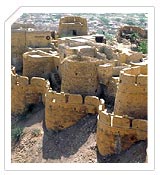|
 Place :
Jaisalmer in the extreme west of the north Indian state of Rajasthan in India. Jaisalmer is located amidst the Great Indian Desert of Thar. Place :
Jaisalmer in the extreme west of the north Indian state of Rajasthan in India. Jaisalmer is located amidst the Great Indian Desert of Thar.
Popular As : Sonar Kila or a Golden Fort, because of its amber hue.
The Jaisalmer Fort -
Jaisalmer Fort, located in the medieval fortress town of Jaisalmer was built in 1156. This second oldest fort in Rajasthan seems to rise out of a desert haze, its yellow sandstone walls and bastions taking on a golden hue in the afternoon sun, which is why it is aptly called Sonar Kila or the Golden Fort or Jaisalmer Fort.
It has narrow winding lanes and four huge gateways, the last one leading to main chowk dominated by the old palace of the Maharwal. Almost one quater of the town's population resides inside the fort. It is approached through Ganesh Pol, Suraj Pol, Bhoot Pol and Hawa Pol. Also, within it are many beautiful havelies and a group of Jain temples dating from the 12th to the 15th centuries.
Today the fort has a population of merchants and shop owners living within its walls. Small, winding lanes are packed with houses, temples, and shops. Jaisalmer fort is alive with people going about their daily routines. Many tourists make it to this exotic town where camel safaris are popular as is the annual desert festival in February. The Havelis or mansions built by the wealthy merchants in the 19th century are famed for their exquisitely carved sandstone facades. Today, many have been converted into shops or hotels. However, one has been preserved as a museum.
The Attractions -
The fort has five palaces called Sarvottam Vilas, Akhai Vilas, Gaj Mahal, Rang Mahal and Moti Mahal-all interconnected behind the seven-storied façade. Small stairs take you from one court to another with superb jail screens shading interiors from the fierce heat and desert wind. The Rang Mahal built by Mool Raj II has some exquisite murals painted on arches and spandrels. From the balconies you get a terrific view of the mammoth ramparts below guarding the small city. Balconies at the Gaj Mahal are also breathtakingly beautiful. The fort contains one third of the city's population within the small houses on the narrow lanes.
The Architecture -
Two hundred and fifty feet tall and reinforced by an imposing crenellated sandstone wall 30 feet high, it has 99 bastion, 92 of which were built between 1633 and 1647. Wells within the fort still provide a regular source of water.
Three strong walls protect the citadel. There is a group of five Jain Tamples within the fort built between the 12th and 15th centuries. Sharp turns on the road topped by high defense gateways made it invincible. At the highest point of the place can be seen an umbrella-Meghadamber symbolic of Krishna.
|


